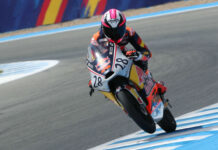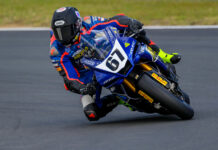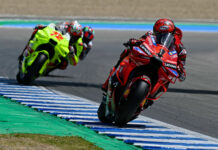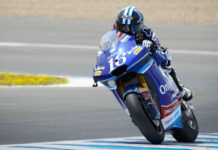Copyright 2003, Roadracing World Publishing, Inc.
Suzuka Facts
Official name of the event – 2003 FIM World Endurance Championship Round 6 “Coca-Cola” Suzuka 8-Hours Endurance Race
Coca-Cola has sponsored the race 15 times since 1984. Three other years the race was sponsored by another Coke product, Sprite.
The 2003 Suzuka 8-Hours is the 26th running of the race. The first event was held in 1978.
The 2003 race has an official song, “Lock On Summer” by the female duo Sortita.
Track Length: 3.611 miles (5.824 km)
Rider Entry Requirements: Must have a FIM license and performance visa in order to enter Japan.
Team Entries Closed: May 22, 2003 but exceptions can be made
Entry Fee: 24,000 Yen (about $240 U.S.) plus optional 6000 Yen ($60 U.S.) MFJ rider medical insurance
Classes:
FIM:
Super-bike (SB)
Super-production (SP)
Stock-sport (ST)
Suzuka Endurance/MFJ (do not pay points toward the World Championship):
JSB1000 (JSB)
XX-Formula Division 1 (XF1)
XX-Formula Division 2 (XF2)
JSB1000 is a class of the All-Japan Road Race Series and was added to that series and the Suzuka 8-Hours line-up to allow privateers to better compete against works 1000cc V-Twin and 750cc four-cylinder Superbikes.
Some Class Technical Requirements:
Super-bike:
World Endurance Championship/FIM spec
Minimum weights
750cc four cylinders = 367 pounds (167 kg)
900cc three cylinders = 367 pounds (167 kg)
1000cc two cylinders = 367 pounds (167 kg)
1000cc four cylinders = 387 pounds (176 kg)
Fuel Capacity – 24 liters (6.3 gallons)
Super-production:
World Endurance Championship/FIM spec
Minimum weights – 24 pounds (11 kg) under homologated weight
Fuel Capacity – 24 liters (6.3 gallons)
Stock-sport:
World Endurance Championship/FIM spec
Minimum weights – 24 pounds (11 kg) under homologated weight
Fuel Capacity – 24 liters (6.3 gallons)
JSB1000:
MFJ Championship spec
Minimum weights
1-3 cylinders = 358.6 pounds (163 kg)
4-5 cylinders = 380.6 pounds (173 kg)
6 or more cylinders = 402.6 pounds (183 kg)
Fuel Capacity – 24 liters (6.3 gallons)
XX-Formula (Both divisions):
Suzuka Road Race Supplementary Regulations spec
Minimum weight – 11 pounds (5 kg) over “prescribed weight”
Fuel Capacity: 24 liters (6.3 gallons)
Qualifying Cut-off Time:
115 percent of Friday’s provisional pole time
The top 66 teams will compose the provisional grid. Teams that have scored points in the World Endurance Championship series prior to Suzuka may also be included on the grid even if they have not qualified in the top 66 provided they have met the 115 percent cut-off time requirement.
Teams eligible for this special provision are: Zongshen Suzuki 1, Zongshen Suzuki 2, Suzuki GB Phase One, X-One Mondial and Team 22 & Tsukigi Racing.
Special Stage:
The top 20 teams from Friday’s qualifying are required to participate in the “Special Stage.” The rider with the second-best qualifying lap time from each team will ride in the “Attack Stage.” The rider with the fastest qualifying lap time from each team will ride in the “Jump-up Stage.”
Both riders will proceed as in World Superbike Superpole, one warm-up lap, one timed flying lap and one cool-down lap.
“Special Stage” teams will be gridded based on the fastest time recorded regardless of which rider does the lap time.
The Le Mans Start:
The race must be started by the rider who recorded the fastest qualifying lap (not the fastest “Special Stage” lap time), but the second rider may start the race if the team has applied for and exception and that application has been approved.
There will be one sighting lap. The penalty for missing the sighting lap will be a 20-second stop-and-go penalty.
Two, consecutive warm-up laps will start with a green light and green flag signaling the riders to run across the track to their machines.
Failure to participate in the warm-up laps will be a 40-second stop-and-go penalty.
For the race start, riders will stand on one side of the track with their foot in a white circle drawn on the racetrack. They must face their motorcycle, which is held by one assistant/mechanic on the other side of the racetrack. When the red start light goes out, riders must run across the track, start their motorcycle’s engine with “a mechanical device on the machine” and ride away.
If the motorcycle cannot start on its own, it may be push-started with the assistant’s help after the field leaves the grid at the direction of a race official.
Teams may start from the end of pit lane after the main body of the field takes the Le Mans-style start.
Two Safety Cars (an Acura NSX and a Acura Integra Type R) may be used to “neutralize” the race if “an incident (climatic conditions or any other cause) puts safety at risk and renders impossible the normal progress of the competition,” according to the Supplementary Regulations. After catching up to the Safety Car, riders will form a single-file line and may not pass the Safety Car or each other. Riders may pit during the Safety Car period but will be held at the pit exit until all of the motorcycles behind the Safety Car have passed. With one lap remaining in the Safety Car session, the Safety Cars’ flashing red lights will change to flashing yellow lights. One Safety Car will exit the track at pit in, the second Safety Car will exit the track after Degner Curve. At the time the second Safety Car leaves the track, a green flag will be displayed at turn 14.5, indicating the race may resume.
In the event of a crash, downed riders must follow the direction of corner marshals. “During the race and qualifying practice, no outside assistance of any kind may be provided. Outside assistance refers to contact of any person with the motorcycle, except by mechanics assigned to the particular motorcycle or by officials on duty…The motorcycle must be propelled only by its own power, physical effort of the rider and gravity.”
Pre-determined short-cut roads to return to the pits may be used, but if the short cuts are used the lap that was started and not completed on the track will not count and another lap will be deducted. If a crashed motorcycle is left in one position on the course for more than one hour, the team will be scored as having withdrawn from the race.
Riders may not ride more than three consecutive hours of the race. If a rider rides for three hours, they must rest for at least 90 minutes before riding again. Generally, riders must rest for one-half of the time they ride before riding again.
Motorcycle repairs:
Repairs made with spare parts can only be made in the pits.
The crankcase and gearbox case may not be replaced during the race.
Fuel tanks may be replaced only if the unit on the motorcycle is damaged, and the damaged tank must be presented to officials.
“Pit work” cannot be done “during the neutralization” or Safety Car period.
Each team is allowed a maximum of seven registered pit crew members, but only four mechanics are allowed to work on the motorcycle at one time. Teams cannot share crew members.
Refueling must take place after all other work to the motorcycle has been completed.
Refueling personnel may stand by with the refueling equipment and fire extinguisher waiting while the four mechanics work on the motorcycle. A crew member must stand by with a fire extinguisher during refueling. This crew member will not be counted as one of the four crew members allowed to work on the motorcycle. The motorcycle’s engine must be turned off during refueling.
Electric or air-operated jack stands are prohibited except for contracted World Endurance Championship teams.
Pit stop procedure violations will be penalized with a 20-second stop-and-go penalty.
Event Schedule:
Saturday, August 2:
9:00 a.m. – 1:00 p.m. 4-Hour Endurance Race (support race)
2:20 – 2:40 p.m. – Free Practice for Special Stage Participants
3:00 – 5:00 p.m. – Special Stage (Superpole, top qualifiers)
Sunday, August 3:
9:00 – 9:45 a.m. – Warm-up
10:45 – 11:00 a.m. Start Procedure
11:00 – 11:20 a.m. Rider Introductions
11:20 – 11:30 a.m. Warm-up Laps
11:30 a.m. – 7:30 p.m. Suzuka 8 Hours Race
7:45 p.m. Podium Ceremony
Number of entries: 80
Entries by class:
JSB1000 – 28
X-Formula Division One – 24
Super-bike – 13
X-Formula Division Two – 6
Sport-Production – 6
Stock-sport – 3
Entries by brand:
Suzuki – 26
Honda – 24
Kawasaki – 15
Yamaha – 12
Ducati – 1
Mondial – 1
BMW – 1
Entries by model:
Suzuki GSX-R1000 – 25
Honda CBR929/954RR – 14
Yamaha YZF-R1 – 9
Honda RC51 – 8
Kawasaki ZX-9R – 8
Kawasaki ZX-7RR – 5
Yamaha YZF-R1/7 – 3
Honda CB1300SF – 2
BMW R1100S – 1
Ducati Monster S4 – 1
Kawasaki GPZ900 – 1
Kawasaki Z1 – 1
Mondial Piega – 1
Suzuki SV1000S – 1
Past winners in the field: 4 (Tohru Ukawa, Sinichi Itoh, Tadayuki Okada, Doug Polen)
In the last eight races, Ukawa, Itoh and Okada have seven wins and 12 podiums between them.
Facts About The Suzuka 8-Hours
Facts About The Suzuka 8-Hours
© 2003, Roadracing World Publishing, Inc.






